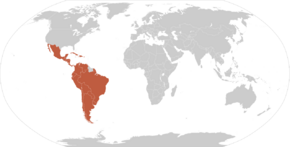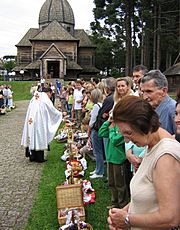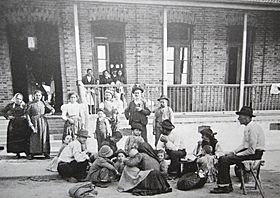White Latin American facts for kids
| Total population | |
|---|---|
| 178.6 million – 219.4 million 31.8 – 39.0% of Latin American population
|
|
| Regions with significant populations | |
| 91M | |
| 38M | |
| 18M | |
| 13M | |
| 11M-56M (est.) | |
| 10M (est.) | |
| 7.16M | |
| 5.9M | |
| 3.5M | |
| 3.3M | |
| 2.7M | |
| 2.6M | |
| 1.6M | |
| 1.3M | |
| 1M | |
| 0.950M | |
| 0.950M | |
| 0.812M | |
| 0.366 | |
| 0.089M | |
| Languages | |
| Major languages Spanish and Portuguese Minor languages Italian, French, English, German, Dutch, and other languages |
|
| Religion | |
| Predominantly Christian (mainly Roman Catholics, with a minority of Protestants), Judaism | |
|
aWhites and mulattos |
|
White Latin Americans or European Latin Americans are Latin Americans who are considered white, typically due to European, or in some cases Levantine, descent. Latin American countries have often encouraged miscegenation, and even a small amount of European ancestry could entail significant upwards social mobility.
People descended from European settlers who arrived in the Americas during the colonial and post-independence periods can be found throughout Latin America. Most of the earliest settlers were Spanish and Portuguese; after independence, the most numerous immigrants have been Spanish and Italians, followed by Germans, Levantine Arabs, Poles, Irish, British, French, Russians, Belgians, Dutch, Scandinavians, Ukrainians, Hungarians, Croats, Swiss, Greeks, and other Europeans.
Composing from 33% to 36% of the population as of 2010[update], according to some sources, White Latin Americans constitute the largest racial-ethnic group in the region. However, because they self-identify as white, it doesn't mean that they are genetically or phenotypically white like a European. White is the self-identification of many Latin Americans in some national censuses. According to a survey conducted by Cohesión Social in Latin America, conducted on a sample of 10,000 people from seven different countries of the region, 34% of those interviewed identified themselves as white.
Being white
Being white is a term that emerged from a tradition of racial classification that developed as Europeans colonized large parts of the world and employed classificatory systems to distinguish themselves from the local inhabitants. However, while most present-day racial classifications include a concept of being white that is ideologically connected to European heritage and specific phenotypic and biological features associated with European heritage, there are differences in how people are classified. These differences arise from the various historical processes and social contexts in which a given racial classification is used. As Latin America is characterized by differing histories and social contexts, there is also variance in the perception of whiteness throughout Latin America.
According to Peter Wade specialist in race concepts of Latin America
...racial categories and racial ideologies are not simply those that elaborate social constructions on the basis of phenotypical variation or ideas about innate difference but those that do so using the particular aspects of phenotypical variation that were worked into vital signifiers of difference during European colonial encounters with others.
In many parts of Latin America being white is more a matter of socio-economic status than specific phenotypic traits, and it is often said that in Latin America "money whitens" Within Latin America there are variations in how racial boundaries have been defined. In Argentina, for example, the notion of mixture has been downplayed, resulting in the country having no real mestizo group. Alternately, in countries like Mexico and Brazil mixture has been emphasized as fundamental for nation-building, resulting in a large group of bi-racial mestizos, in Mexico, or tri-racial pardos, in Brazil, who are considered neither fully white nor fully non-white.
Unlike in the United States where ancestry may be used exclusively to define race, by the 1970s, Latin American scholars came to agree that race in Latin America could not be understood as the "genetic composition of individuals" but instead must be "based upon a combination of cultural, social, and somatic considerations". In Latin America, a person's ancestry may not be decisive in racial classification. For example, full-blooded siblings can often be classified as belonging to different races (Harris 1964).
For these reasons the distinction between "white" and "mixed", and between "mixed" and "black" and "indigenous", is largely subjective and situational, meaning that any attempt to classify by discrete racial categories is fraught with problems.
History
People of European origin began to arrive in the Americas in the 15th century. After the Wars of Independence, the elites of most of the countries of the region concluded that their underdevelopment was caused by their populations being mostly Amerindian, Mestizo or Mulatto; so a major process of "whitening" was required, or at least desirable. Most Latin American countries then implemented blanqueamiento policies to promote European immigration, and some were quite successful, especially Argentina, Uruguay, and Brazil. From the late 19th century to the early 20th century, the number of European immigrants who arrived far surpassed the number of original colonists. Between 1821 and 1932, of a total 15 million immigrants who arrived in Latin America, Argentina received 6.4 million, and Brazil 5.5 million.
Admixture
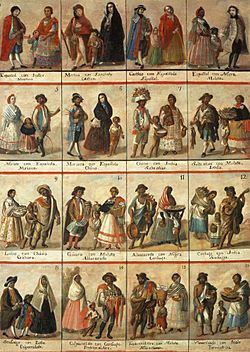
Since European colonization, Latin America's population has had a long history of intermixing, so that many Latin Americans who have Native American or sub-Saharan African or, rarely, East Asian ancestry have European ancestry as well. The casta system, a primarily race-based classification that was used in colonial Latin America designated people according to its racial background, with the main classifications being indio (used to refer to Native American people), criollo (those of complete European ancestry born in Latin America, or in cases, people who were 7/8 or more European and 1/8 Indigenous or less), castizo (3/4 European, 1/4 Indigenous), or mestizo (1/2 European, 1/2 Indigenous), negro (Sub-Saharan Africans) mulato (1/2 European, 1/2 African), zambo (1/2 African, 1/2 Indigenous), Pardo (persons with European, African and Indigenous ancestry), and Peninsulares who were Europeans born in Spain or other European countries such as Portugal in the case of Portuguese colonies.
As in Spain, persons of even remote Jewish or Moorish ancestry were not allowed to enroll in the Spanish Army or the Catholic Church in the colonies. Applicants to both institutions, and their spouses, had to obtain a Limpieza de sangre (purity of blood) certificate that proved that they had no Jewish or Moorish ancestors, in the same way as those in the Peninsula did. However, being a medieval concept that targeted exclusively those religious groups, it was never an issue among the native population in the colonies of the Spanish Empire, which by law allowed people from all racial groups to join the army, with being of the Catholic faith the only prerequisite. One notable example was that of Francisco Menendez, a freed-black military officer of the Spanish Army during the 18th century at the Gracia Real de Santa Teresa de Mose fort in St. Augustine, Florida.
Although historically both Colonial and Imperial Brazil had institutionalized discrimination against citizens who were deemed people of color, it never had a casta system like that of Hispanic America. White Brazilians equivalent in status to the Hispanic criollo could have less than 80% European (overwhelmingly Portuguese) ancestry. Having some Amerindian and black African ancestry—which is widespread among white Brazilians, among all social classes in its five geographic regions since the 16th to 17th centuries—as well as having Moorish, Jewish, Arab, or Romani ancestry, affected social status less than in Hispanic America, This does not mean that the social status of "fully non-white" people (people of color who are not mulattoes, mestizos, zambos, pardos, etc.—in short, Mixed-race Brazilians—even with Caucasian features; "westernized" Brazilians with non-Caucasian phenotypes; or people with known non-European ancestry was equal to that of Brazilian elites.
Genetic studies
| Country | Proportion |
|---|---|
| Canada | 90% |
| Uruguay | 83% |
| USA | 79% |
| Cuba | 72% |
| Brazil | 71% |
| Argentina | 71% |
| Puerto Rico | 64% |
| Costa Rica | 61% |
| Nicaragua | 57% |
| Colombia | 57% |
| Venezuela | 56% |
| Chile | 52% |
| Honduras | 50% |
| Cayman Islands | 50% |
| Aruba | 50% |
| Dominican Republic | 47% |
| Ecuador | 42% |
| Mexico | 42% |
| Suriname | 40% |
| Guatemala | 40% |
| Bermuda | 37% |
| Belize | 38% |
| Bolivia | 21% |
| Bahamas | 16% |
| Netherlands Antilles | 15% |
| Curaçao | 15% |
| Barbados | 14% |
| Anguilla | 6% |
| Antigua and Barbuda | 4% |
Populations
The largest white population in Latin America is in Brazil, with 91 million whites out of 190.7 million total Brazilians, or 47.7% of the total population, as of the 2010 census. Brazil's southern region contains the highest concentration, at 79% of the population. Argentina also contains a large numbers of whites. In terms of percentage of the total population, Uruguay, Argentina, and Costa Rica have the highest concentrations of whites, who constitute 80–90% of their total populations. The smallest concentration is in Honduras, with only 1%.
| Country | Percentage of the local population | Population in (millions) |
|---|---|---|
| 88 | 3.4 | |
| 86 | 36.7 | |
| 82.7 | 3.2 | |
| 75.8 | 2.6 | |
| 64.1 | 7.16 | |
| 52 | 9.1 | |
| 47.7 | 91 | |
| 47 | 56 | |
| 43.6 | 13.1 | |
| 37 | 18.2 | |
| 18.5 | 2.7 | |
| 17 | 1 | |
| 16 | 2.0 | |
| 15 | 4.4 | |
| 12.0 | 0.6 | |
| 10 | 0.720 | |
| 6.1 | 0.330 | |
| 5 | 0.950 | |
| 5 (est.) | 0.524 (est.) | |
| 3.0 | 0.210 | |
| 1.0 | 0.089 |
Self-reported races by percent in Latin America according to the 2016 Latinobarómetro survey.
| Country | Mestizo | White | Indigenous | Mulatto | Black | Other race | Asian |
|---|---|---|---|---|---|---|---|
| Ecuador | 81 | 4 | 7 | 3 | 3 | 0 | 1 |
| Paraguay | 81 | 3 | 3 | 1 | 1 | 2 | 0 |
| Peru | 76 | 6 | 7 | 1 | 1 | 1 | 1 |
| El Salvador | 68 | 10 | 5 | 4 | 4 | 0 | 2 |
| Nicaragua | 67 | 6 | 8 | 2 | 3 | 0 | 1 |
| Honduras | 62 | 1 | 13 | 16 | 2 | 1 | 1 |
| Bolivia | 57 | 4 | 27 | 1 | 1 | 1 | 0 |
| Panama | 53 | 16 | 7 | 5 | 10 | 1 | 1 |
| Mexico | 52 | 6 | 19 | 2 | 0 | 3 | 1 |
| Colombia | 47 | 26 | 5 | 5 | 6 | 2 | 0 |
| Venezuela | 33 | 32 | 4 | 21 | 8 | 0 | 0 |
| Costa Rica | 31 | 40 | 4 | 17 | 3 | 1 | 1 |
| Dominican Republic | 29 | 11 | 4 | 24 | 26 | 0 | 3 |
| Argentina | 26 | 61 | 1 | 1 | 1 | 3 | 0 |
| Chile | 59 | 30 | 8 | 1 | 0 | 2 | 0 |
| Brazil | 27 | 41 | 1 | 13 | 17 | 1 | 0 |
| Guatemala | 32 | 17 | 45 | 1 | 1 | 1 | 0 |
| Uruguay | 7 | 74 | 1 | 4 | 3 | 3 | 0 |
| Latin America | 47 | 24 | 9 | 6 | 5 | 1 | 1 |
North America
Mexico

Estimates in regards to Mexico's white population range from 9% to almost 47% with the later figure, coming from a recent nationwide survey conducted by the Mexican government as a mean to address the problems of racism that Mexicans of mainly Indigenous or African ancestry suffer at hands of a society that favors light skinned, European looking Mexicans. The majority are of Spanish descent. However, many non-Iberian immigrants (mostly French) arrived during the Second Mexican Empire in the 1860s. During the late 19th and early 20th centuries, immigrants from Italy, Germany, Ireland, the United Kingdom, Lebanon, and Palestine also made Mexico their home. In the 20th century, white Americans, Canadians, Greeks, Romanians, Portuguese, Armenians, Poles, Russians, and Jews, along with many Spanish refugees fleeing the Spanish Civil War, also settled in Mexico.
Mexico’s northern and western regions have the highest percentages of European population, according to the American historian Howard F. Cline the majority of Mexicans in these regions have no native admixture and their aspect resemble that of northern Spaniards. In the north and west of Mexico, the indigenous tribes were substantially smaller than those found in central and southern Mexico, and also much less organized, thus they remained isolated from the rest of the population or even in some cases were hostile towards Mexican colonists. The northeast region, in which the indigenous population was eliminated by early European settlers, became the region with the highest proportion of whites during the Spanish colonial period. However, recent immigrants from southern Mexico have been changing, to some degree, it's demographic trends.
In the last decade, due to Mexico's economic growth, immigration to the country has increased, including Europeans, who leave their countries (particularly France and Spain) in search of better work opportunities. People from the United States have arrived as well, and now make up more than three-quarters of Mexico’s roughly one million documented foreigners, up from around two-thirds in 2000. In that time, more people from the United States have been added to the population of Mexico than Mexicans to that of the United States, according to government data in both nations.
Caribbean
Cuba
White people in Cuba make up 64.1% of the total population, according to the 2012 census, with the majority being of diverse Spanish descent. However, after the mass exodus resulting from the Cuban Revolution in 1959, the number of white Cubans actually residing in Cuba diminished. Today, the various records that claim to show the percentage of whites in Cuba are conflicting and uncertain; some reports (usually coming from Cuba) still report a similar-to-pre-1959 number of 65%, and others (usually from outside observers) report 40–45%. Despite most white Cubans being of Spanish descent, many others are of French, Portuguese, German, Italian, or Russian descent. During the 18th, 19th, and early 20th centuries, large waves of Canarians, Catalans, Andalusians, Castilians, and Galicians immigrated to Cuba. Between 1901 and 1958, more than a million Spaniards arrived in Cuba from Spain; many of these and their descendants left after Castro's Communist regime took power. One further significant ethnic influx was from various Middle Eastern nations. Many Jews have also immigrated there, some of them Sephardic.
An autosomal study from 2014 found the genetic makeup in Cuba to be 72% European, 20% African, and 8% Native American.
Dominican Republic
The 1750 estimates show that there were 30,863 whites, out of a total population of 70,625, in the colony of Santo Domingo. The census of 1920 was the first national enumeration. The second census, taken in 1935, covered race, religion, literacy, nationality, labor force, and urban–rural residence.
| European and white population 1750 - 1960 Census | ||||
|---|---|---|---|---|
| Year | Population | Percent | Total population | Reference |
| 1750 | 30,863 | 43.7% | 70,625 | |
| 1790 | 40,000 | 32.0% | 125,000 | |
| 1846 | 80,000 | 48.5% | ||
| 1920 | 223,144 | 24.9% | 894,665 | |
| 1935 | 192,732 | 13.0% | 1,479,417 | |
| 1950 | 600,994 | 28.14% | 2,135,872 | |
| 1960 | 489,580 | 16.1% | 3,047,070 | |
| 2006 Survey | 1.6 Million | 13.6% | ||
According to the CIA World Factbook, white persons in the Dominican Republic are 16% of the total population, with the vast majority being of Spanish descent. Notable other ancestries includes French, Italian, Lebanese, German, and Portuguese.
The government of Rafael Leónidas Trujillo made a point of increasing the white population, or "whitening" the racial composition of the country, by rejecting black immigrants from Haiti and local blacks as foreigners. He also welcomed Jewish refugees in 1938 and Spanish farmers in the 1950s as part of this plan. The country's German minority is the largest in the Caribbean.
Haiti
The white and the mulatto population of Haiti make up about 5% of its population, while 95% is "black".
That 5% minority group comprises people of many different ethnic and national backgrounds, who are French, Spanish, Middle Eastern, Portuguese, Russian, Dutch, Swiss, Armenian, Poles (Polish legion), Jews (arriving from the Polish legion and during the Holocaust), Germans (18th century and World War I), and Italian.
Martinique
White people in Martinique represent 5% of the population. As Martinique is an overseas French department, most whites are French.
Puerto Rico
An early Census on the island was conducted by Governor Francisco Manuel de Lando in 1530. An exhaustive 1765 census was taken by Lieutenant General Alexander O'Reilly, which, according to some sources, showed 17,572 whites out of a total population of 44,883. The censuses from 1765 to 1887 were taken by the Spanish government who conducted them at irregular intervals. The 1899 census was taken by the United States War Department. Since 1910, Puerto Rico has been included in every decennial census taken by the United States.

| European or white population 1530 - 2010 Census | |||||||
|---|---|---|---|---|---|---|---|
| Year | Population | Percent | Ref(s) | Year | Population | Percent | Ref(s) |
| 1530 | 333a, 426b | 8-10.0 | ab | 1887 | 474,933 | 59.5 | |
| 1765 | 17,572 | 39.2 | 1897 | 573,187 | 64.3 | ||
| 1775 | 30,709 | 40.4 | 1899 | 589,426 | 61.8 | ||
| 1787 | 46,756 | 45.5 | 1910 | 732,555 | 65.5 | ||
| 1802 | 78,281 | 48.0 | 1920 | 948,709 | 73.0 | ||
| 1812 | 85,662 | 46.8 | 1930 | 1,146,719 | 74.3 | ||
| 1820 | 102,432 | 44.4 | 1940 | 1,430,744 | 76.5 | ||
| 1827 | 150,311 | 49.7 | 1950 | 1,762,411 | 79.7 | ||
| 1830 | 162,311 | 50.1 | 2000 | 3,064,862 | 80.5 | ||
| 1836 | 188,869 | 52.9 | 2010 | 2,825,100 | 75.8 | ||
| 1860 | 300,406 | 51.5 | |||||
| 1877 | 411,712 | 56.3 | |||||
White Puerto Ricans of European, mostly Spanish, descent are said to comprise the majority, with 75.8% of the population identifying as white. In 1899, one year after the U.S invaded and took control of the island, 61.8% identified as white. In 2000, for the first time in fifty years, the census asked people to define their race and found the percentage of whites had risen to 80.5% (3,064,862); not because there has been an influx of whites to the island (or an exodus of non-White people), but a change of race perceptions, mainly because Puerto Rican elites wished to portray Puerto Rico as the "white island of the Antilles", partly as a response to scientific racism.
From the beginning of the 20th century, American observers remarked on the "surprising preponderance of the white race" on the island. One travel writer called Puerto Rico "the whitest of the Antilles". In a widely distributed piece, a geologist wrote that the island was "notable among the West Indian group for the reason that its preponderant population is of the white race". In a more academic book he reiterated that "Porto Rico, at least, has not become Africanized".
During the 19th century, hundreds of Corsican, French, Middle Eastern, and Portuguese families, along with large numbers of immigrants from Spain (mainly from Catalonia, Asturias, Galicia, the Balearic Islands, Andalusia, and the Canary Islands) and numerous Spanish loyalists from Spain's former colonies in South America, arrived in Puerto Rico. Other settlers have included Irish, Scots, Germans, and Italians. Thousands of immigrants were granted land from Spain during the Real Cedula de Gracias de 1815 (Royal Decree of Graces of 1815), which allowed European Catholics to settle in the island with a certain amount of free land.
According to a genetic research by the University of Brasilia, Puerto Rican genetic admixture consists in a 60.3% European, 26.4% African, and 13.2% Amerindian ancestry.
Saint Barthélemy
Most of the population in Saint Barthélemy are French-speaking descendants of the first settlers from Normandy and Brittany.
Central America
Costa Rica

From the late 19th century to when the Panama Canal opened, European migrants used Costa Rica to get across the isthmus of Central America to reach the west coast of the United States (California).
In Costa Rica, estimates of the percentage of white people vary between 77% and 82%, or about 3.1 – 3.5 million people. The white and mestizo populations combined equal 83%, according to the CIA World Factbook. Costa Rican European ancestry is mostly Spanish, although a significant number is descended from Italian, Greek, German, English, Dutch, French, Irish, Portuguese, Lebanese, or Polish families. Other ethnic groups include Russians, Danes, Belgians, Croats, Hungarians, Turks, Armenians and Georgians.
Many of the first Spanish colonists in Costa Rica may have been Jewish converts to Christianity who were expelled from Spain in 1492 and fled to colonial backwaters to avoid the Inquisition. The first sizable group of self-identified Jews immigrated from Poland, beginning in 1929. From the 1930s to the early 1950s, journalistic and official anti-Semitic campaigns fueled harassment of Jews; however, by the 1950s and 1960s, the immigrants won greater acceptance. Most of the 3,500 Costa Rican Jews today are not highly observant, but they remain largely endogamous.
El Salvador
According to the official 2007 Census in El Salvador, 12.7% of Salvadorans identified with being white.
According to genetic research by the University of Brasilia, Salvadoran genetic admixture shows an average of 45.2% Amerindian, 45.2% European, and 9.7% African ancestry.
Guatemala
| Official census | |||||
|---|---|---|---|---|---|
| Year | White | Mayan | Mestizo | Others/immigrants | |
| 1898 | 8.0 | 74.7 | 15.1 | 2.2 | |
| 1940 | 29.0 | 53.2 | 15.1 | 2.7 | |
| 1980 | 13.0 | 46.5 | 38.9 | 1.6 | |
| 2002 | 16.4 | 42.5 | 39.4 | 1.7 | |
| 2010 | 18.5 | 38.2 | 41.3 | 2.0 | |
| Racial composition (percentages) by the official census of Guatemala. |
|||||
A 2010-2012 national study estimated that white Guatemalans are 18.5% of the population (2.7 million), with the majority descendants of Germans, followed those of Spaniards, French, Italians, English, Swedish, Belgian, Swiss, Danish, Norwegian, Dutch, Russian, Scottish, Irish, Welsh, and other parts of Europe. There are also descendants of Americans, Canadians, and whites from Latin American nations such as Argentina and Costa Rica.
During the 19th and 20th centuries, Guatemala had massive immigration from Germany, Belgium, and Italy, as well as, to a lesser extent, Spain, France, Great Britain, Denmark, Switzerland, Netherlands, Scandinavian countries, Ireland, and other European countries. From the mid-nineteenth century to the early twentieth, immigration from Russia, Poland, and Greece was encouraged by grants of land for coffee fincas and vineyards in the areas of Cobán, Zacapa, Guatemala City, Quetzaltenango, Chiquimula, El Progreso, and other places.
By 1940, the percentage of Guatemalans of European origin had reached 29%, becoming the majority in the capital and in the east, with significant populations in Verapaces, Quetzaltenango, and several areas in the southwest. But by 1980, with a fall-off of European immigration, and a significant increase in indigenous and mestizo families, that figure had fallen to 13%. Later, after armed conflict that destroyed many non-white families, the percentage had risen, as well as that of castizos (mixture of the mestizo population and European descent) and mestizos with European predominance.
Nicaragua

According to a 2014 research published in the journal Genetics and Molecular Biology and to a 2010 research published in the journal "Physical Antropology", European ancestry predominates in 69% of Nicaraguans, followed by African ancestry in 20%, and lastly Native American ancestry in 11%, making Nicaragua the country with the highest proportion of European ancestry in Central America. .. Non-genetic data from the CIA World Factbook establish that from Nicaragua's 2016 population of 5,966,798, around 69% are mestizo, 17% white, 5% Native American, and 9% black and other races. This fluctuates with changes in migration patterns. The population is 58% urban as of 2013[update].. Nicaraguan white are mainly of Spanish, German, Italian, Portuguese, Belgian, and French ancestry.
In the 19th century, Nicaragua experienced a wave of immigration, primarily from Europe. In particular, families from Germany, Italy, Spain, France, and Belgium moved to Nicaragua to set up businesses with money they brought from Europe. They established many agricultural businesses, such as coffee and sugarcane plantations, as well as newspapers, hotels, and banks.
There is also a small Middle Eastern–Nicaraguan community of Syrian, Armenian, Palestinian, Jewish, and Lebanese people in Nicaragua, with a total population of about 30,000.
Panama
White Panamanians are 10% of the population, with those of Spanish ancestry being in the majority. Other ancestries includes Dutch, English, French, German, Swiss, Danish, Irish, Greek, Italian, Lebanese, Portuguese, Polish, Russian, and Ukrainian. There is also a sizable and influential Jewish community.
Honduras
Honduras contains perhaps the smallest percentage of whites in Latin America, with only about 1% (about 89,000) of the total population being classified in this group.
South America
Argentina
The ancestry of Argentines is mostly European, with both Native American and African contributions. A 2009 autosomal DNA study found the Argentine population to average 78.5 percent European, 17.3 percent Native American, and 4.2 percent sub-Saharan African. A 2012 autosomal DNA study found the genetic composition of Argentines to be 65% European, 31% Native American, and 4% African.
Argentina's National Institute of Statistics and Censuses (INDEC) does not conduct ethnic/racial censuses; so, no official data exist on the percentage of white Argentines today. Nevertheless, various sources estimate the white population of European descent to be between 85% and 86.4%. These figures increase to between 86.1% and 89.7% if non-European Caucasian groups (such as Jews, Lebanese, Armenians, and other Middle Easterners) are also counted. These percentages show an estimated population of 34-36 million white people in Argentina.
White Argentines are dispersed throughout the country, but their greatest concentration is in the east-central region of Pampas, the southern region of Patagonia, and in the west-central region of Cuyo. Their concentration is smaller in the north-eastern region of Litoral, and is much smaller in the north-western provinces of Salta, Jujuy, Tucumán, Catamarca, La Rioja, and Santiago del Estero, which was the most densely populated region of the country (mainly by Amerindian and Mestizo people) before the wave of immigration of 1857-1940 and was the area where European newcomers settled the least. During the last few decades, due to internal migration from the northern provinces—as well as to immigration from Bolivia, Peru, and Paraguay—the percentage of white Argentines in certain areas of Greater Buenos Aires and the provinces of Salta and Jujuy has decreased significantly.
The white population residing in Argentina is mostly descended from immigrants who arrived from Europe and the Middle East between the late 19th- and early 20th centuries, with a smaller proportion from Spaniards of the colonial period. From 1506 to 1650—according to M. Möner, Peter Muschamp, and Boyd-Bowman—out of a total of 437,669 Spaniards who settled in the American Spanish colonies, between 10,500 and 13,125 Peninsulares settled in the Río de la Plata region. The colonial censuses conducted after the creation of the Viceroyalty of the Río de la Plata showed that the proportion of Spaniards and Criollos was significant in the cities and surrounding countryside, but not so much in the rural areas. The 1778 census of Buenos Aires, ordered by Viceroy Juan José de Vértiz, revealed that, of a total population of 37,130 inhabitants (in both the city and surrounding countryside), the Spaniards and Criollos numbered 25,451, or 68.55% of the total. Another census, carried out in the Corregimiento de Cuyo in 1777, showed that the Spaniards and Criollos numbered 4,491 (or 51.24%) out of a population of 8,765 inhabitants. In Córdoba (city and countryside) the Spanish/Criollo people comprised a 39.36% (about 14,170) of 36,000 inhabitants.
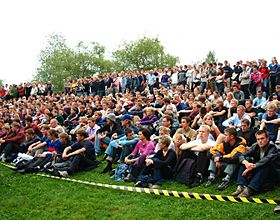
In 1992, after the fall of the Communist regimes of the Soviet Union and its allies, the governments of Western Europe were worried about a possible mass exodus from Central Europe and Russia. President Carlos Menem offered to receive part of that emigratory wave in Argentina. On December 19, 1994, Resolution 4632/94 was enacted, allowing "special treatment" for applicants who wished to emigrate from the republics of the ex-Soviet Union. From January 1994 until December 2000, a total 9,399 Central and Eastern Europeans traveled and settled in Argentina. Of the total, 6,720 were Ukrainians (71.5%), 1,598 Russians (17%), 526 Romanians, Bulgarians, Armenians, Georgians, Moldovans, and Poles, and 555 (5.9%) traveled with a Soviet passport. 85% of the newcomers were under age 45 and 51% had tertiary-level education, so most of them integrated quite rapidly into Argentine society, although some had to work for lower wages than expected at the beginning.
Bolivia
White people in Bolivia make up 5% of the nation's population. The white population consists mostly of criollos, which consist of families of unmixed Spanish ancestry descended from the Spanish colonists and Spanish refugees fleeing the 1936–1939 Spanish Civil War. These two groups have constituted much of the aristocracy since independence. Other groups within the white population are Germans, who founded the national airline Lloyd Aéreo Boliviano, as well as Italians, Americans, Basques, Lebanese, Croats, Russians, Polish, English, Irish, and other minorities, many of whose members descend from families that have lived in Bolivia for several generations.
Brazil


Brazil is one of the few countries in Latin America that includes racial categories in its censuses: Branco (White), Negro (Black), Pardo (Multiracial), Amarelo (Yellow) and Indígena (Amerindian), with categorization being by self-identification. Taking into account the data provided by the last National Household Survey, conducted in 2010, Brazil would possess the most numerous white population in Latin America, given that a 47.7% – 91 million people – of Brazilians self-declared as "Brancos". Comparing this survey with previous censuses, a slow but constant decrease in the percentage of self-identified white Brazilians can be seen: in the 2000 Census it was 53.7%, in the 2006 Household Survey it was 49.9%, and in the last, 2008, survey it decreased to the current 48.4%. Some analysts believe that this decrease is evidence that more Brazilians have come to appreciate their mixed ancestry, re-classifying themselves as "Pardos". Furthermore, some demographers estimate that a 9% of the self-declared white Brazilians have a certain degree of African and Amerindian ancestry, which, if the "one-drop rule" were applied, would classify them as "Pardos".
The white Brazilian population is spread throughout the country, but it is concentrated in the four southernmost states, where 79.8% of the population self-identify as white. The states with the highest percentage of white people are Santa Catarina (86.9%), Rio Grande do Sul (82.3%), Paraná (77.2%) and São Paulo (70.4%). Another five states that have significant proportions of whites are Rio de Janeiro (55.8%), Mato Grosso do Sul (51.7%), Espírito Santo (50.4%), Minas Gerais (47.2%) and Goiás (43.6%). São Paulo has the largest population in absolute numbers with 30 million whites.
In the 18th century, an estimated 600,000 Portuguese arrived, including wealthy immigrants, as well as poor peasants, attracted by the Brazil Gold Rush in Minas Gerais. By the time of Brazilian independence, declared by emperor Pedro I in 1822, an estimated 600,000 to 800,000 Europeans had come to Brazil, most of them male settlers from Portugal. Rich immigrants who established the first sugarcane plantations in Pernambuco and Bahia, and New Christians and Gypsies fleeing from religious persecution, were among the early settlers.
After independence, Brazil saw several campaigns to attract European immigrants, which were prompted by a policy of Branqueamento (Whitening). During the 19th century, the slave labor force was gradually replaced by European immigrants, especially Italians. This mostly took place after 1850, as a result of the end of the slave trade in the Atlantic Ocean and the growth of coffee plantations in the São Paulo region. European immigration was at its peak between the mid-19th and the mid-20th centuries, when nearly five million Europeans immigrated to Brazil, most of them Italians (58.5%), Portuguese (20%), Germans, Spaniards, Poles, Lithuanians, and Ukrainians. Between 1877 and 1903, 1,927,992 immigrants entered Brazil, an average of 71,000 people per year, with the peak year being 1891, when 215,239 Europeans arrived.
After the First World War, the Portuguese once more became the main immigrant group, and Italians fell to third place. Spanish immigrants rose to second place because of the poverty that was affecting millions of rural workers. Germans were fourth place on the list; they arrived especially during the Weimar Republic, due to poverty and unemployment caused by the First World War. The numbers of Europeans of other ethnicities increased; among them were people from Poland, Russia, and Romania, who emigrated in the 1920s, probably because of politic persecution. Other peoples emigrated from the Middle East, especially from what now are Syria and Lebanon. During the period 1821–1932, Brazil received an estimated 4,431,000 European immigrants.
After the end of the Second World War, European immigration diminished significantly, although between 1931 and 1963 1.1 million immigrants entered Brazil, mostly Portuguese. By the mid-1970s, many Portuguese had immigrated to Brazil after the independence of Portugal's African colonies—from Angola, Mozambique and Guinea-Bissau. Some came from Macao, because of the dictatorship there.
Chile

A 2015 autosomal DNA study found out Chile to be 55.16% European, 42.38% Native American and 2.44% African, using LAMP-LD modeling; and 54.38% European, 43.22% Native American, and 2.40% African, using RFMix. An autosomal DNA study from 2014 found the results to be 51.85% (± 5.44%) European, 44.34% (± 3.9%) Native American, and 3.81% (± 0.45%) African.
Studies estimates the white population at 20%, to 52.7% of the Chilean population. According to genetic research by the University of Brasilia, Chilean genetic admixture consists of 51.6% European, 42.1% Amerindian, and 6.3% African ancestry. According to an autosomal genetic study of 2014 carried out among soldiers in the city of Arica, Northern Chile, the European admixture goes from 56.8% in soldiers born in Magallanes to 41.2% for the ones who were born in Tarapacá. According to an study from 2013, conducted by the Candela Project in Northern Chile as well, the genetic admixture of Chile is 52% European, 44% Native American, and 4% African.
According to a study performed in 2014, 37.9% of Chileans self-identified as white, a subsequent DNA tests showed that the average self identifying white was genetically 54% European.
Genotype and phenotype in Chileans vary according to social class. 13% of lower-class Chileans have at least one non-Hispanic European surname, compared to 72% of those who belong to the upper-middle-class. Phenotypically, only 9.6% of lower-class girls have light-colored eyes—either green or blue—where 31.6% of upper-middle class girls have such eyes. Blonde hair is present in 2.2% and 21.3%, of lower-class and upper-middle girls respectively, whilst black hair is more common among lower-class girls (24.5%) than upper-middle class ones (9.0%).
Chile was usually an unattractive place for migrants, simply because it was far from Europe and relatively difficult to reach. However, during the 18th century an important flux of emigrants from Spain populated Chile. They were mostly Basques, who vitalized the economy and rose rapidly in the social hierarchy, becoming part of the political elite that still dominates the country. An estimated 1.6 million (10%) to 3.2 million (20%) Chileans have a surname (one or both) of Basque origin. The Basques liked Chile because of its similarity to their native land: cool climate, with similar geography, fruits, seafood, and wine.
The Spanish was the most significant European immigration to Chile, although there was never a massive immigration, such as happened in neighboring Argentina and Uruguay, and, therefore, the Chilean population wasn't "whitened" to the same extent. However, it is undeniable that immigrants have played a role in Chilean society. Between 1851 and 1924, Chile received only 0.5% of the total European immigration to Latin America, compared to 46% for Argentina, 33% for Brazil, 14% for Cuba, and 4% for Uruguay. This was because such migrants came across the Atlantic, not the Pacific, and before the construction of the Panama Canal, Europeans preferring to settle in countries close to their homelands, instead of taking the long route through the Straits of Magellan or across the Andes. In 1907, the European-born reached a peak of 2.4% of the Chilean population, decreasing to 1.8% in 1920, and 1.5% in 1930.
It is estimated that nearly 5% of the Chilean population is of Asian descent, chiefly from the Middle East—i.e., Jews/Israelis, Palestinians, Syrians, and Lebanese—totaling about 800,000. Chile is home to a large population of immigrants, mostly Christian, from the Levant. Roughly 500,000 Palestinian descendants are believed to reside in Chile.
About 5% of the Chilean population has some French ancestry. Over 700,000 (4.5%) Chileans may be of British (English, Scottish, Irish or Welsh) origin. Another significant immigrant group is Croatian. The number of their descendants today is estimated to be 380,000, or 2.4% of the population. Other authors claim that close to 4.6% of the Chilean population must have some Croatian ancestry.
After the failed liberal revolution of 1848 in the German states, a significant German immigration took place, laying the foundation for the German-Chilean community. Sponsored by the Chilean government, to "unbarbarize" and colonize the southern region, these Germans (including German-speaking Swiss, Silesians, Alsatians and Austrians) settled mainly in Valdivia, Llanquihue, Chiloé, and Los Ángeles. The Chilean Embassy in Germany estimated that 150,000 to 200,000 Chileans are of German origin.
184,000 are descendants of Italians. Chileans of Greek descent are estimated to number 90,000 to 120,000, most of them living in the Santiago or the Antofagasta areas, Chile being one of the top 5 countries in terms of number of Greek descendants. The descendants of the Swiss number 90,000 Other groups of European descendants are found in smaller numbers.
Colombia
The proportion of the Colombian population with primarily European ancestry is estimated at approximately 20%, but in the 2005 Census, 37% of the total population self-identified as white. According to genetic research by the University of Brasilia, Colombian genetic admixture indicates 45.9% European, 33.8% Amerindian, and 20.3% African ancestry.

Within 100 years after the first Spanish settlement, nearly 95 percent of all Native Americans in Colombia had died. The majority of the deaths of Native Americans were the cause of diseases such as measles and smallpox, which were spread by European settlers. Many Native Americans were also killed by armed conflicts with European settlers.
White Colombians are mostly descendants of Spaniards, although Italian, German, Irish, Portuguese, and Lebanese Colombians are found in significant numbers. Many Spanish colonists came searching for gold, while other Spaniards established themselves as leaders of social organizations teaching natives the Christian faith and the ways of European civilization. Catholic priests provided education for Native Americans that otherwise was unavailable.
There are many Colombian-German companies focused on finance, science, education, technology and innovation, and engineering.
Ecuador
According to the 2010 National Population Census, 6.1% of the population self-identified as white, down from 10.5% in 2001. In Ecuador, being white is more an indication of social class than of ethnicity. Classifying oneself as white is often done to claim membership to the middle class and to distance oneself from the lower class, which is associated being "Indian". For this reason the status of blanco is claimed by people who are not primarily of European heritage. According to genetic research by the University of Brasilia, Ecuadorian genetic admixture indicates 64.6% Amerindian, 31.0% European, and 4.4% African ancestry.
White Ecuadorians, mostly criollos, are descendants of Spanish colonists and also Spanish refugees fleeing the 1936–1939 Spanish Civil War. Most still hold large amounts of lands, mainly in the northern Sierra, and live in Quito or Guayaquil. There is also a large number of white people in Cuenca, a city in the southern Andes of Ecuador, due to the arrival of Frenchmen in the area, who came to measure the arc of the Earth. Cuenca, Loja, and the Galápagos attracted German immigration during the early 20th century. The Galápagos also had a small Norwegian fishing community until they were asked to leave. There are sizable populations of Italian, French, German, Basque, Portuguese, and Greek descent, as well as a small Ecuadorian Jewish population. Ecuador's Jews consists of Sephardic Jews arriving in the South of the country in the 16th and 17th centuries and Ashkenazi Jews during the 1930s in the main cities of Quito and Cuenca.
French Guiana
12% of the population is white, mostly French.
Paraguay
Ethnically, culturally, and socially, Paraguay has one of the most homogeneous populations in South America. Because of José Gaspar Rodríguez de Francia's 1814 policy that no white Spaniards and Europeans could intermarry among themselves (they could only marry blacks, mulattoes, mestizos or the native Guaraní), a measure taken to avoid white supremacy being established in Paraguay (De Francia believed that all men were equal as well), it was within little more than one generation that most of the population were of mixed racial origin.
The exact percentage of the white Paraguayan population is not known because the Paraguayan census does not include racial or ethnic identification, save for the indigenous population, which was 1.7% of the country's total in the 2002 census. Other sources estimate the sizes of other groups, the mestizo population being estimated at 95% by the CIA World Factbook, with all other groups totaling 5%. Thus, whites and the remaining groups (Asians, Afro-Paraguayans, others) make up approximately 3.3% of the total population. Such a reading is complicated, because, as elsewhere in Latin America, "white" and "mestizo" are not mutually exclusive (people may identify as both).
Due to the European migration in the 19th and 20th centuries, the majority of whites are of German descent (including Mennonites), with others being of French, Italian, Spanish, and Portuguese descent. Many are southern and southeastern Brazilians (brasiguayos), as well as Argentines and Uruguayans, and their descendants. People from such regions are generally descendants of colonial settlers and/or more recent immigrants.
In 2005, 600 families of Volga Germans who migrated to Germany after the fall of the Soviet Union, re-migrated and established a new colony, Neufeld, near Yuty (Caazapá Department), in southeastern Paraguay.
Peru
White Peruvians are 19.5% of the population, according to the last census of "Composicion étnica del Peru". and 15% or 4.6 million people according to the CIA World Factbook. They are descendants primarily of Spanish colonists, and also of Spanish refugees fleeing the Spanish Civil War. After World War II, many German refugees fled to Peru and settled in large cities, while others descend from Italian, French (mainly Basques), Austrian or German, Portuguese, British, Russians, Croats, Lebanese, Jordanian, and Syrian immigrant families. The majority of the whites live in the largest cities, and are concentrated in the northern coastal cities of Trujillo, Chiclayo, Piura, and of course the capital Lima. Cajamarca and San Martín Region, and the highlands of northwestern Peru, are also places with strong Spanish, and other European, influence and ethnic presence. The only southern city with a significant white population is Arequipa.
According to a genetic research by the University of Brasilia, Peruvian genetic admixture indicates 73.0% Amerindian, 15.1% European, and 11.9% African ancestry.
Uruguay
A 2009 DNA study in the American Journal of Human Biology showed the genetic composition of Uruguay as primarily European, with Native American ancestry ranging from one to 20 percent and sub-Saharan African from seven to 15 percent, depending on the region.
Between the mid-19th and the early 20th centuries, Uruguay received part of the same migratory influx as Argentina, although the process started a bit earlier. During 1850-1900, the country welcomed four waves of European immigrants, mainly Spaniards, Italians and Frenchmen. In smaller numbers came British, Germans, Swiss, Russians, Portuguese, Poles, Bulgarians, Hungarians, Ukrainians, Lithuanians, Estonians, Dutch, Belgians, Croatians, Lebanese, Armenians, Greeks, Scandinavians, and Irish. The demographic impact of these migratory waves was greater than in Argentina, Uruguay going from having 70,000 inhabitants in 1830, to 450,000 in 1875, and a million inhabitants by 1900, its population thus increasing fourteen-fold in only 70 years. Between 1840 and 1890, 50%-60% of Montevideo's population was born abroad, almost all in Europe. The Census conducted in 1860 showed that 35% of the country's population was made up by foreigners, although by the time of the 1908 Census this figure had dropped to 17%.
Recently many European and American immigrants have entered the country seeking peace and security, or escaping from the pollution and voracious tax systems in their countries of origin. In 1997, the Uruguayan government granted residence rights to only 200 European/American citizens; in 2008 the number of residence rights granted increased to 927.
Venezuela


According to the official Venezuelan census, although "white" literally involves external issues such as light skin, shape and color of hair and eyes, among others, the term "white" has been used in different ways in different historical periods and places, and so its precise definition is somewhat confusing. For this reason, White Venezuelan is used to describe the Venezuelan citizen of European origin.
According to the 2011 National Population and Housing Census, 43.6% of the population identified themselves as white people. A genomic study shows that about 60.6% of the Venezuelan gene pool has European origin. Among the Latin American countries in the study (Argentina, Bahamas, Brazil, Chile, Costa Rica, Colombia, El Salvador, Ecuador, Jamaica, Mexico, Peru, Puerto Rico, and Venezuela), Brazil, Venezuela, and Argentina exhibit the highest European contribution.
The Venezuelan gene pool indicates a 60.6% European, 23.0% Amerindian, and 16.3% African ancestry. Spaniards were introduced into Venezuela during the colonial period. Most of them were from Andalusia, Galicia, Basque Country and from the Canary Islands. Until the last years of World War II, a large part of European immigrants to Venezuela came from the Canary Islands, and their cultural impact was significant, influencing the development of Castilian in the country, its gastronomy and customs. With the beginning of oil production during the first decades of the 20th century, employees of oil companies from the United States, United Kingdom, and the Netherlands established themselves in Venezuela. Later, in the middle of the century, there was a new wave of immigrants originating from Spain (mainly from Galicia, Andalucia, and Basque country, some being refugees from the Spanish Civil War), Italy (mainly from southern Italy and the Veneto region), and Portugal (from Madeira), as well as from Germany, France, England, Croatia, the Netherlands, other European countries, and the Middle East (Lebanon), encouraged by a welcoming immigration policy to a prosperous, rapidly developing country where educated and skilled immigrants were needed.


